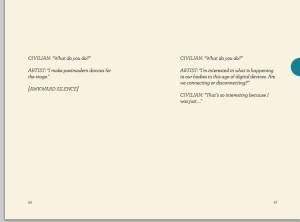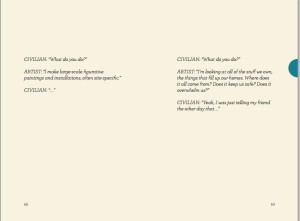It is ten years this month that Charles Leadbeater and Paul Miller first started talking about Pro-Ams, the Professional-Amateur whose dedicated pursuit of an avocation brought them on par with professional practitioners. I have written a fair bit upon the subject over the years.
When the topic comes up for discussion in the arts, one central question often arises (or lurks shallowly in the subtext) about whether amateurs really can perform to the standard professionals possessed of a keen eye honed by experience and education can.
Essentially, if we let the amateurs get involved, will quality and artistic merit be supplanted by work that panders to popular tastes and doesn’t require any effort to understand?
This is a question that Nina Simon, Director of the Santa Cruz Museum of History and Art has had to struggle with as a practical matter. While she has increased the fortunes of her museum since assuming the director role, her means have not been without criticism.
Recently her programming decisions were discussed in in a Wall Street Journal article, Everybody’s an Art Curator. The article uses Simon’s museum as the basis of discussing a national trend of involving the community in curatorial decisions. The article mentions the departure of one of Simon’s curatorial staff and disagreements with an artist over the context in which her show was hung. The article discusses friction at other museums around the country as they attempt to enact similar programs.
Nina Simon posted about the WSJ article on her Museum 2.0 blog this week, linking to two more in depth considerations of the idea of outsourcing curation broached in “Everybody’s an Art Curator” by Ed Rodley.
As I read all these posts and articles, it occurred to me that there is a high likelihood that a lot of the blame for the weaknesses of involving amateurs probably lies with the arts organization itself.
As Rodley observes:
“I think if you were to look at a large sample of museum projects with participatory elements, you’d find plenty that had poorly thought out and articulated goals and dubious educational value. Which is something that the field as a whole could stand to look at closely.”
Arts organizations have a history of not investing enough patience and resources in a new initiative. Common discussions in the field involve the misguided expectation that new audiences segments will respond positively and feel they are being served on the basis of one event aimed at them a year. What is required are accompanying outreach efforts, conversations, and shifts in making the attendance environment more appealing to your target groups.
Chances are, Rodley is right on the money when he suggests that insufficient attention has been paid to program design.
On the other hand, arts organizations frequently run into a lack of understanding about how difficult their work is to accomplish. I have frequently encountered renters who start a conversation which “Oh it is just a simple…,” having not considered how everything is going to fall into place.
Nina Simon makes a similar observation about the perception that amateur curators are a strategy aimed at reducing and replacing staff.
“Community is not a commodity. We don’t involve people in content development to “boost ticket sales.” It’s neither “quick” nor “inexpensive” to mount exhibitions that include diverse community stories. Yes, community involvement is at the heart of our shifted, successful business model. But that business model requires experienced staff who know how to empower people, facilitate meaningful participation, respond to community issues and interests, and ignite learning. It’s not cheap. It’s not easy. It’s the work we feel driven to do to build a museum that is of and for our community.”
I feel like Simon’s efforts at community involvement actually help educate people about the work that goes into putting a show together. For example,
“Hack the Museum,” a show that invited a mix of outside professionals to live at the museum for 48 hours and build a new exhibit from the permanent collection.”
Yes, the results of their efforts may be mixed. But how exciting is it for people to camp out in a museum for two days and learn the process? I can’t imagine that giving 75 people a tour of the curatorial department would be as effective in helping them understand the process. Nor would it likely engender the investment that the participants felt. Nina made some posts about it here and here and the participants looked like they had a blast.
I am fairly certain she isn’t passing off the work of community participants as professional choices since that would be counter to her goal of convincing all visitors that their involvement with the museum is meaningful.
Those of us who work in the performing arts will often grouse that so much gets a standing ovation or accolades of “as good as professionals” when it doesn’t deserve it. However, the performing arts may have an advantage over visual arts in that there is a rough sense of a continuum between elementary school recital and full blown concert by a professional symphony orchestra.
The criteria by which to judge and classify visual art in terms of quality is less distinct, and not only because so many people think their kids could produce what they are looking at.
How many people outside of the gallery and museum world know what standards are applied in curating a show? Where exactly does your Pinterest page fall between the refrigerator and the walls of the Metropolitan Museum of Art? Where do you go to find out?
You could do worse than a sleepover at a museum.





